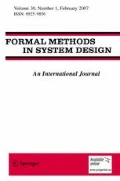Abstract
We develop a model-checking algorithm for a logic that permits propositions to be defined using greatest and least fixed points of mutually recursive systems of equations. This logic is as expressive as the alternation-free fragment of the modal mu-calculus identified by Emerson and Lei, and it may therefore be used to encode a number of temporal logics and behavioral preorders. Our algorithm determines whether a process satisfies a formula in time proportional to the product of the sizes of the process and the formula; this improves on the best known algorithm for similar fixed-point logics.
Similar content being viewed by others
References
E.M. Clarke, E.A. Emerson, and A.P. Sistla. Automatic verification of finite state concurrent systems using temporal logic specifications.ACM TOPLAS, 8(2):244–263 (1986).
J.-C. Fernandez.Aldébaran: Une Système de Vérification par Réduction de Processus Communicants. Ph.D. Thesis, Université de Grenoble, (1988).
J. Malhotra, S.A. Smolka, A. Giacalone, and R. Shapiro. Winston: A tool for hierarchical design and simulation of concurrent systems.Proceedings of the Workshop on Specification and Verification of Concurrent Systems, University of Stirling, Scotland, pp. 140–152 (1988).
J. Richier, C. Rodriguez, J. Sifakis, and J. Voiron. Verification in Xesar of the sliding window protocol. InProceedings 7th Symp. on Protocol Specification, Testing, and Verification, Zurich, pp. 235–250 (1987).
V. Roy and R. de Simone. Auto/Autograph. InComputer-Aided Verification '90, Piscataway, NJ, pp. 477–491 (1990).
R. Cleaveland and B. Steffen. When is ‘partial’ complete? A logic-based proof technique using partial specifications.Proceedings of the Fifth Symposium on Logic in Computer Science, Philadelphia, PA, pp. 440–449 (1990).
S. Graf and B. Steffen. Using interface specifications for compositional reduction.Computer-Aided Verification '90, pp. 57–76 (1990).
R. Cleaveland, J. Parrow, and B. Steffen. The concurrency workbench.Proceedings Workshop on Automatic Verification Methods for Finite-State Systems, Lecture Notes in Computer Science, 407:24–37 (1989). Also to appear inACM TOPLAS.
R. Cleaveland, J. Parrow, and B. Steffen. A semantics-based verification tool for finite-state systems.Proceedings of the 9th Symposium on Protocol Specification, Testing, and Verification, Enschede, Holland, pp. 287–302 (1989).
R. Cleaveland and B. Steffen. “Computing Behavioural Relations, Logically.” InProceedings of the Eighteenth International Colloquium on Automata, Languages and Programming, Lecture Notes in Computer Science, 510:127–138 (1991).
B.U. Steffen and A. Ingólfsdóttir. Characteristic formulae for CCS with divergence. To appear inInformation and Computation.
E.A. Emerson, and C.-L. Lei, Efficient model checking in fragments of the propositional mucalculus.Proceedings of the First Symposium on Logic in Computer Science, Cambridge, MA, pp. 267–278 (1986).
M. Fischer and R. Ladner. Propositional dynamic logic of regular programs.Journal of Computer and System Sciences, 18:194–211 (1979).
D. Kozen. Results on the propositional μ-calculus.Theoretical Computer Science, 27:333–354 (1983).
K. Larsen. Proof systems for Hennessy-Milner logic with recursion.Proceedings of Colloque sur Algèbre et Arbres en Programmation, Nancy, France, pp. 215–230 (1988).
A. Tarski. A lattice-theoretical fixpoint theorem and its applications.Pacific Journal of Mathematics 25(2):285–309 (1955).
A. Arnold and P. Crubille. A linear algorithm to solve fixed-point equations on transition systems.Information Processing Letters, 29:57–66 (September 1988).
D. Walker. Bisimulations and divergence.Proceedings of the Third Symposium on Logic in Computer Science, Edinburgh, Scotland, pp. 186–192 (1988).
R. Cleaveland and M.C.B. Hennessy. Testing equivalence as a bisimulation equivalence.Proceedings of the Workshop on Automatic Verification Methods for Finite-State Systems, Lecture Notes in Computer Science, 407:11–23 (1989). Also to appear inFundamental Aspects of Computing.
B.U. Steffen. Characteristic formulae. InProceedings of the Sixteenth International Colloquium on Automata, Languages and Programming, Lecture Notes in Computer Science, 372:723–733 (1989).
R. Cleaveland, M. Dreimüller, and B. Steffen. Faster model-checking for the modal mu-calculus. To appear inProceedings of the 1992 Workshop on Computer-Aided Verification. Lecture Notes in Computer Science.
H. Andersen. Model checking and Boolean graphs.Proceedings of ESOP '92, Rennes, France, pp. 1–19, Springer-Verlag (1992).
R. Cleaveland. Tableau-based model-checking in the propositional mu-calculus.Acta Information, 27:725–747 (1990).
C. Stirling and D. Walker. Local model checking in the modal mu-calculus. InProceedings of TAPSOFT '89, Lecture Notes in Computer Science, 351:369–383 (1989).
G. Winskel. “Model checking in the modalv-calculus.” InProceedings of the Sixteenth International Colloquium on Automata, Languages and Programming, Lecture Notes in Computer Science, 372:761–772 (1989).
K. Larsen. Efficient local correctness checking. To appear inProceedings of the 1992 Workshop on Computer-Aided Verification.
Author information
Authors and Affiliations
Rights and permissions
About this article
Cite this article
Cleaveland, R., Steffen, B. A linear-time model-checking algorithm for the alternation-free modal mu-calculus. Form Method Syst Des 2, 121–147 (1993). https://doi.org/10.1007/BF01383878
Issue Date:
DOI: https://doi.org/10.1007/BF01383878




